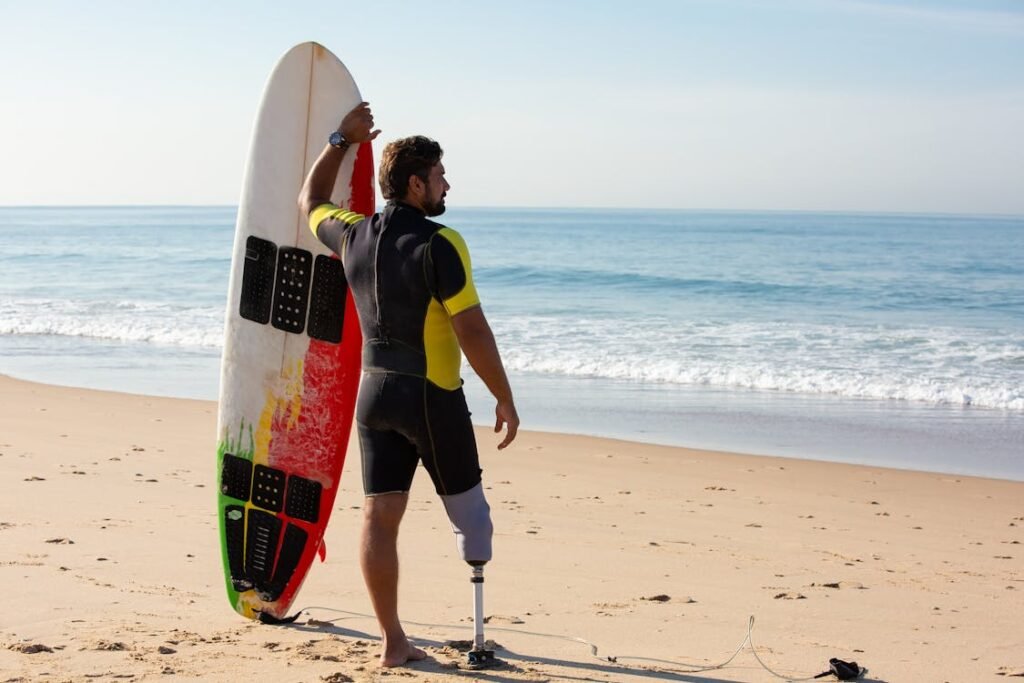Losing a limb is life-changing, and one of the biggest challenges after amputation is relearning balance. Whether someone is using a prosthetic limb or relying on assistive devices, staying steady on their feet can feel difficult at first. The body needs time to adjust, and without proper balance training, even simple movements like standing, walking, or turning can feel unsteady.
Balance is not just about staying upright—it is about feeling secure, confident, and in control of movement. Poor balance can lead to falls, muscle strain, and unnecessary fatigue, making daily tasks more difficult. But with the right training, amputees can regain stability, move more naturally, and feel safer in their own body.
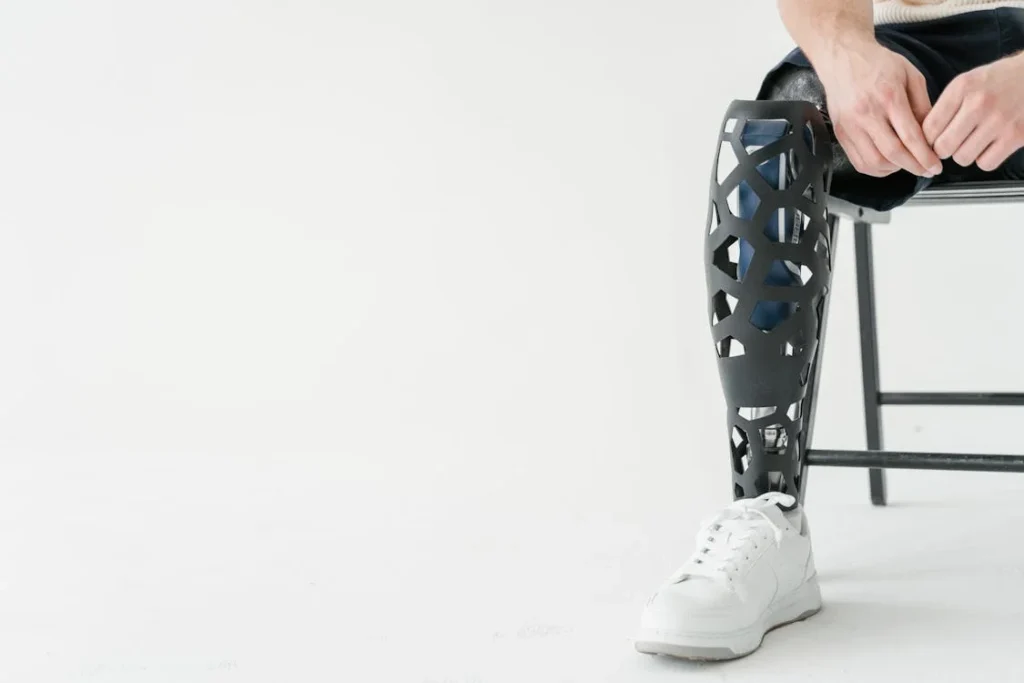
Why Balance is Crucial After an Amputation
Balance is something most people take for granted until it is disrupted. After an amputation, the body must adjust to a new weight distribution, a different way of moving, and, in many cases, the use of a prosthetic limb.
Without proper balance, even basic movements like standing up from a chair, walking, or reaching for an object can feel unsteady.
Poor balance can lead to falls, muscle fatigue, and a lack of confidence in movement, which can slow down recovery and make everyday life more challenging.
How the Body Adapts to Limb Loss
When a limb is lost, the body’s center of gravity shifts. For lower-limb amputees, this means the weight that was once evenly distributed across both legs is now concentrated on the remaining limb.
The muscles, joints, and spine must compensate to maintain stability, which can sometimes cause postural imbalances, back pain, and joint strain.
For upper-limb amputees, the lack of a natural counterbalance on one side of the body can affect posture and coordination.
Simple actions like reaching, lifting, or carrying objects require extra effort as the body learns to function with a new weight distribution.
The Role of the Core and Remaining Limb
Balance is controlled by several parts of the body, but the core muscles and remaining limb play the most significant roles.
The core, which includes the abdominal, lower back, and pelvic muscles, provides stability and keeps the body upright. When these muscles are weak, it becomes harder to stand and move without wobbling or swaying.
The remaining limb also takes on extra responsibility after an amputation. It must bear more weight, provide stability, and assist in movement.
If the muscles in this limb are weak or underdeveloped, it can be difficult to maintain control, especially when using a prosthetic. Strengthening both the core and the remaining limb is key to improving balance and preventing strain on the body.
Why Prosthetic Users Need Balance Training
For those using a prosthetic limb, learning to balance with an artificial extension of the body takes time and practice. A prosthetic does not provide the same instant feedback as a natural limb, meaning the brain and muscles must work harder to maintain stability.
Many new prosthetic users experience hesitation, uneven weight distribution, and difficulty walking on different surfaces due to balance challenges.
Without proper training, some individuals develop compensatory movements, such as favoring one side of the body or taking unnatural steps to avoid discomfort.
Over time, these habits can lead to joint pain, back strain, and reduced mobility. Balance training helps prosthetic users develop better weight distribution, stronger muscle control, and more fluid movements, making it easier to walk and stand with confidence.
Preventing Falls and Building Confidence
One of the biggest fears among amputees is falling. A lack of balance increases the risk of trips and falls, which can cause injuries and setbacks in recovery.
Many individuals become hesitant to move freely, leading to reduced physical activity, muscle weakness, and loss of independence.
Balance training helps reduce this fear by giving amputees the strength and control they need to move safely. As stability improves, so does confidence. Everyday activities become easier and less tiring, allowing individuals to focus on their goals rather than worrying about falling.

How to Improve Balance After an Amputation
Regaining balance is not something that happens overnight. It takes consistent training, patience, and the right techniques to rebuild stability and confidence.
The body must learn to move in a new way, relying on different muscles for support. With time and effort, amputees can develop a stronger sense of control, smoother movements, and a reduced risk of falls.
Strengthening the Core for Better Stability
The core muscles play a critical role in maintaining balance and posture. Without a strong core, movements can feel unsteady, and the risk of falling increases.
Many amputees unknowingly overcompensate with their back or shoulders, leading to muscle strain and discomfort. Strengthening the core helps keep the spine aligned, improves weight distribution, and makes standing or walking feel more natural.
Simple core exercises, such as engaging the abdominal muscles while sitting upright or practicing controlled breathing, can help build stability from the inside out.
More advanced movements, like seated torso rotations or pelvic tilts, can further enhance core strength, leading to better overall balance.
Training the Remaining Limb for Support
For lower-limb amputees, the remaining leg becomes the primary source of support. This means it must be strong, flexible, and capable of handling more weight than before.
If the muscles in the remaining limb are weak, walking and standing will feel unbalanced, making it harder to use a prosthetic or move confidently.
Exercises that improve leg strength and flexibility, such as controlled weight shifts and seated leg lifts, help the remaining limb adapt to its new role. Over time, this creates a more stable foundation, reducing the risk of falls and making movements feel smoother.
Practicing Weight Shifting and Postural Control
One of the most important aspects of balance training is learning how to distribute weight correctly.
Many amputees struggle with uneven weight shifting, either relying too much on their remaining limb or not fully trusting their prosthetic. This can lead to poor posture, discomfort, and instability.
Practicing gentle weight shifts from side to side while standing or sitting helps the body get used to even weight distribution. Over time, these movements become more natural, allowing amputees to stand, walk, and turn without hesitation.
Using a Prosthetic with Confidence
For prosthetic users, balance training goes hand in hand with learning to trust the device. Many new users feel unstable at first because a prosthetic limb does not provide the same instant feedback as a natural limb.
The key is to practice controlled, deliberate movements, allowing the brain and muscles to adjust to the prosthetic’s mechanics.
Walking on different surfaces, such as carpets, ramps, and outdoor paths, helps develop adaptive balance skills.
Practicing standing on the prosthetic for longer periods also strengthens endurance and control, reducing the likelihood of stumbling. The more an amputee engages with their prosthetic in a structured way, the more natural and effortless movement becomes.
Relearning Everyday Movements
Many common activities, such as getting out of a chair, reaching for an object, or turning around, require balance. Without training, these simple actions can feel difficult or unsafe.
By practicing slow, controlled repetitions of these movements, amputees can develop the muscle memory needed to perform them confidently.
Balance is not just about staying upright—it is about moving freely, comfortably, and without fear. The more an individual trains their body to handle different situations, the more secure and independent they will feel in everyday life.
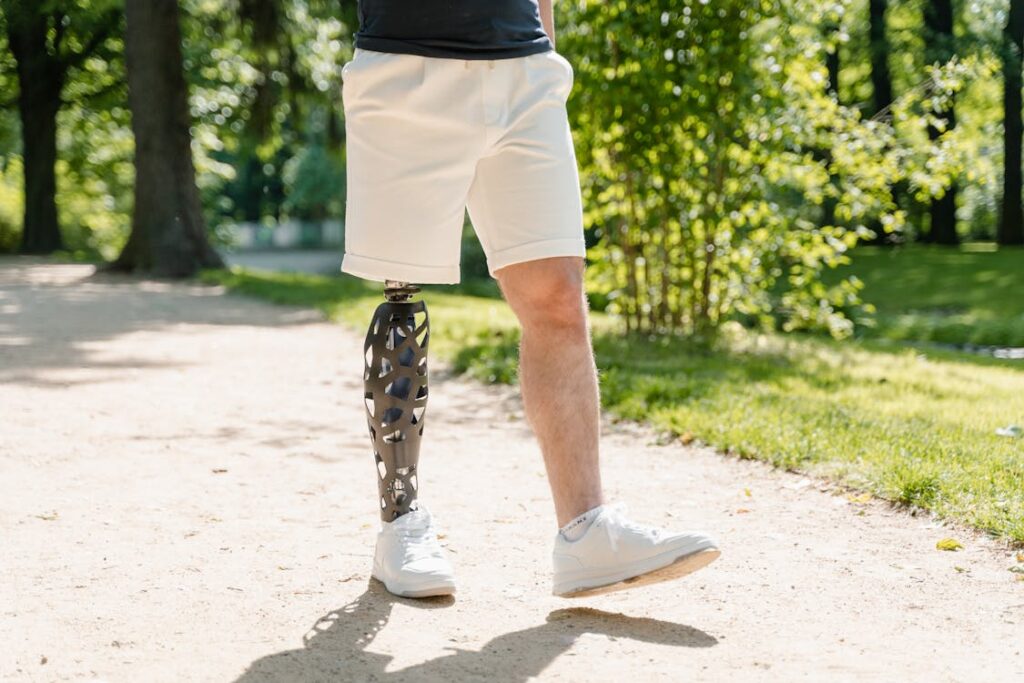
Overcoming Common Balance Challenges for Amputees
Regaining balance after an amputation comes with challenges, both physical and psychological. Many amputees experience fear of falling, muscle imbalances, and difficulties adjusting to new movement patterns.
These challenges can slow down recovery and make mobility feel frustrating. However, with the right approach, they can be overcome, leading to greater independence and confidence in daily life.
Fear of Falling and How to Overcome It
One of the biggest obstacles to balance training is the fear of falling. After an amputation, many individuals become hesitant to move freely, especially when using a prosthetic for the first time.
This fear can create a cycle where less movement leads to weaker muscles and even more instability, increasing the actual risk of falling.
The best way to break this cycle is through gradual exposure to movement in a controlled environment.
Starting with seated balance exercises, practicing weight shifts in front of a stable surface, and slowly increasing activity levels helps build trust in the body’s ability to stay upright.
The more frequently amputees engage in these movements, the more natural they feel, reducing hesitation and fear.
Working with a physical therapist or prosthetist can also provide reassurance and guidance. Many people feel safer knowing that a professional is there to support them as they practice new movements. Over time, small successes add up, and confidence replaces anxiety.
Compensatory Movements and Their Long-Term Effects
When balance feels unsteady, the body naturally compensates by shifting weight unevenly or using incorrect movement patterns.
These compensatory habits might feel helpful in the short term, but over time, they can cause joint pain, muscle strain, and inefficient walking patterns.
For lower-limb amputees, common compensations include leaning heavily on the remaining limb, swaying the upper body for balance, or taking unnatural steps to avoid discomfort.
For upper-limb amputees, poor posture, excessive shoulder strain, and awkward weight distribution are common issues.
Breaking these habits requires awareness and corrective training. Practicing proper posture, evenly distributing weight, and using a mirror or video feedback can help amputees recognize and correct imbalances.
Strengthening the core, back, and remaining limb also provides the muscular support needed for better movement.
Adapting to Different Surfaces and Environments
Balance is not just about standing still—it’s about being able to move confidently across a variety of surfaces.
Many amputees feel comfortable on smooth indoor floors but struggle on uneven ground, grass, or inclines. This can make outdoor activities, shopping trips, or navigating unfamiliar places feel intimidating.
Practicing movement on different surfaces in a safe environment helps train the brain and muscles to react appropriately. Walking on a soft carpet, stepping onto a rubber mat, or practicing short walks on outdoor pavement can help the body adapt.
Using a prosthetic on various terrains is a skill that improves with practice, and the more an amputee engages in real-world movement, the easier it becomes.
Adjusting to Changes in Weight and Strength Over Time
The body continues to change after an amputation. Muscle tone, weight distribution, and prosthetic fit may shift over months or years, requiring adjustments in balance training.
Amputees who stay physically active and regularly strengthen their core and remaining limbs tend to adapt more easily to these changes.
Regular check-ups with a prosthetist ensure that the prosthetic fits correctly and does not cause instability. If balance suddenly feels off, it may not be a strength issue but a sign that the prosthetic needs an adjustment.
Being aware of the body’s needs and making proactive changes leads to better long-term mobility.
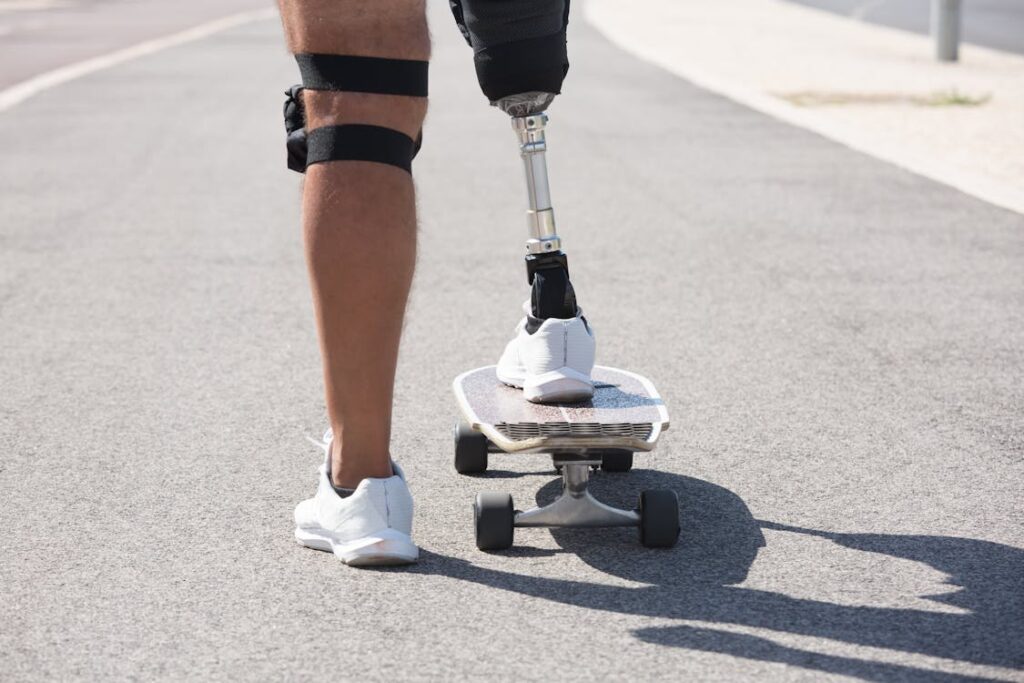
The Role of Physical Therapy in Balance Training
Recovering balance after an amputation is not something that happens automatically—it requires targeted training and expert guidance.
Physical therapy plays a crucial role in helping amputees strengthen their muscles, improve posture, and learn to move with confidence. Working with a trained therapist can make a significant difference in how quickly and effectively an individual regains stability.
Customizing Balance Training for Individual Needs
Every amputee’s experience is different, which is why one-size-fits-all approaches don’t work. A physical therapist assesses an individual’s strength, flexibility, posture, and prosthetic fit to create a training program that addresses specific challenges.
For someone struggling with uneven weight distribution, therapy might focus on core engagement and controlled weight shifts. For another person who has difficulty walking on different surfaces, sessions may include step training and stability drills.
Therapists also help amputees recognize and correct compensatory movements that could lead to long-term discomfort or injury. By identifying areas of weakness and imbalance, they create exercises that make everyday activities easier and more natural.
Building Strength for Long-Term Stability
Physical therapy doesn’t just focus on short-term recovery—it lays the foundation for lifelong mobility and independence. A well-designed program strengthens the muscles that support balance, including the core, lower back, and remaining limb.
This makes walking, standing, and even sitting for long periods more comfortable and less tiring.
Incorporating functional exercises, such as stepping onto a curb, turning around smoothly, or getting in and out of a car, prepares amputees for real-world movements.
The stronger and more conditioned the body becomes, the less effort it takes to stay balanced in daily life.
Learning to Trust the Prosthetic Limb
For new prosthetic users, balance therapy is just as much about building confidence as it is about strengthening muscles. Many amputees feel hesitant to put full weight on their prosthetic, especially in the early stages of use.
Physical therapists teach techniques to gradually increase weight-bearing, helping individuals feel more secure in their movements.
Practicing activities like stepping forward and backward, walking up and down inclines, and shifting weight side to side helps the brain and body adjust to the prosthetic limb.
Over time, these exercises create muscle memory, allowing movements to feel more natural and effortless.
Gait Training for a Smoother Walking Pattern
Walking with a prosthetic limb requires coordination, balance, and rhythm. Without proper training, some individuals develop an unnatural gait, leading to extra strain on the back, hips, and remaining limb.
Physical therapy focuses on teaching proper walking mechanics, ensuring that each step is stable and controlled.
Gait training exercises focus on even weight distribution, proper foot placement, and smooth transitions between steps. With consistent practice, walking becomes less tiring and more fluid, allowing amputees to move with greater ease and confidence.
Using Assistive Devices to Improve Balance
In the early stages of rehabilitation, assistive devices like parallel bars, walkers, or canes provide extra stability. Physical therapists guide amputees on when and how to use these tools, ensuring they develop balance gradually without becoming dependent on them.
The goal is to transition from assisted movement to independent mobility, reducing reliance on external support as balance improves. A well-structured therapy program ensures that each step of this transition is safe, effective, and empowering.
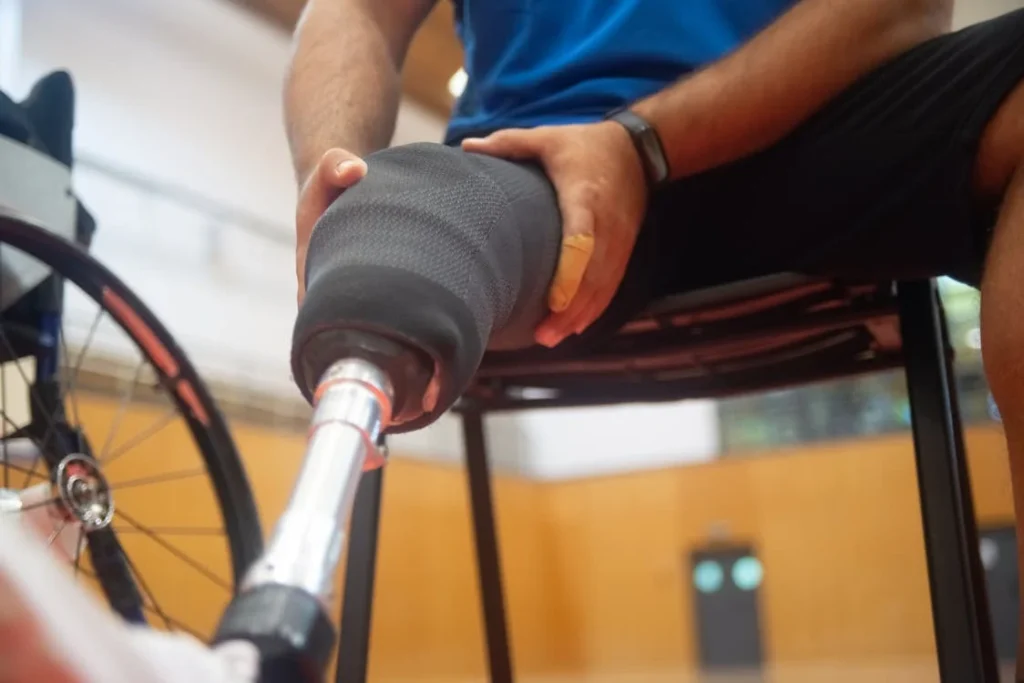
Incorporating Balance Training into Daily Life
Balance training should not be limited to physical therapy sessions—it needs to become a natural part of everyday activities. The more an amputee practices stability and coordination in real-life situations, the faster they regain confidence in movement.
By making small adjustments to daily routines, balance training becomes something that happens throughout the day rather than just during rehabilitation exercises.
Engaging Core Muscles During Routine Activities
One of the simplest ways to improve balance is by engaging the core muscles while sitting, standing, or walking.
Instead of slouching when sitting in a chair, keeping the back straight and gently tightening the abdominal muscles improves posture and core strength over time. When walking, focusing on even weight distribution and controlled steps helps reinforce proper balance.
Every time an amputee shifts weight from one side to another, stands up from a seated position, or reaches for something, they are training their body to maintain stability in different situations.
Being mindful of these small movements makes a significant impact on overall control and confidence.
Practicing Controlled Movements in Different Environments
Balance is not just about standing still—it’s about moving confidently in a variety of environments. Many amputees feel comfortable indoors on smooth floors but struggle when walking on uneven ground, stairs, or slippery surfaces.
Practicing movement in different settings helps train the body to adjust quickly to changing conditions.
Starting in a safe, controlled environment, such as practicing walking on a carpet or a yoga mat, helps develop a better sense of stability.
Gradually introducing new surfaces like outdoor pavements, grass, or tiled floors builds confidence and reduces the risk of tripping or stumbling when navigating real-world environments.
Using Mirrors and Video Feedback for Posture Awareness
Many balance issues come from poor posture or uneven weight distribution, but without visual feedback, it can be difficult to recognize these imbalances.
Using a mirror while practicing standing, walking, or performing weight shifts allows amputees to see how their body is aligned and make corrections.
Recording short videos of walking patterns can also be helpful. Watching these recordings helps individuals identify areas that need improvement, such as favoring one side too much or taking uneven steps.
With this awareness, it becomes easier to make conscious adjustments and develop a more natural, fluid walking motion.
Building Endurance for Longer Periods of Movement
Balance is not just about standing still—it also involves maintaining stability while moving for extended periods.
Many amputees experience fatigue after walking or standing for too long, which can make balance harder to maintain. Improving endurance through gradual increases in movement time helps build the strength needed to stay active without feeling exhausted.
Taking short, controlled walks and slowly increasing the duration each day allows the body to adapt.
Strengthening the legs, core, and lower back helps improve posture and reduces strain, making longer periods of movement feel more comfortable and natural.
Practicing Safe Falling and Recovery Techniques
Even with excellent balance training, occasional falls can happen. Learning how to fall safely and recover from a fall can prevent serious injuries and boost confidence in movement.
Practicing controlled, gentle falls on soft surfaces with the guidance of a physical therapist can help amputees understand how to protect themselves if they lose balance.
Learning techniques for getting back up safely without straining the remaining limb or prosthetic ensures that a fall does not become a major setback.
Turning Balance Training into a Lifelong Habit
Balance is something that must be maintained over time. Even after an amputee has successfully adjusted to their new way of moving, regular balance exercises help prevent future complications such as joint pain, poor posture, or reduced mobility.
Making small efforts each day to practice core engagement, weight distribution, and smooth movement ensures that stability remains strong for years to come.
By integrating balance training into everyday life, amputees can enjoy greater freedom, confidence, and independence in everything they do.
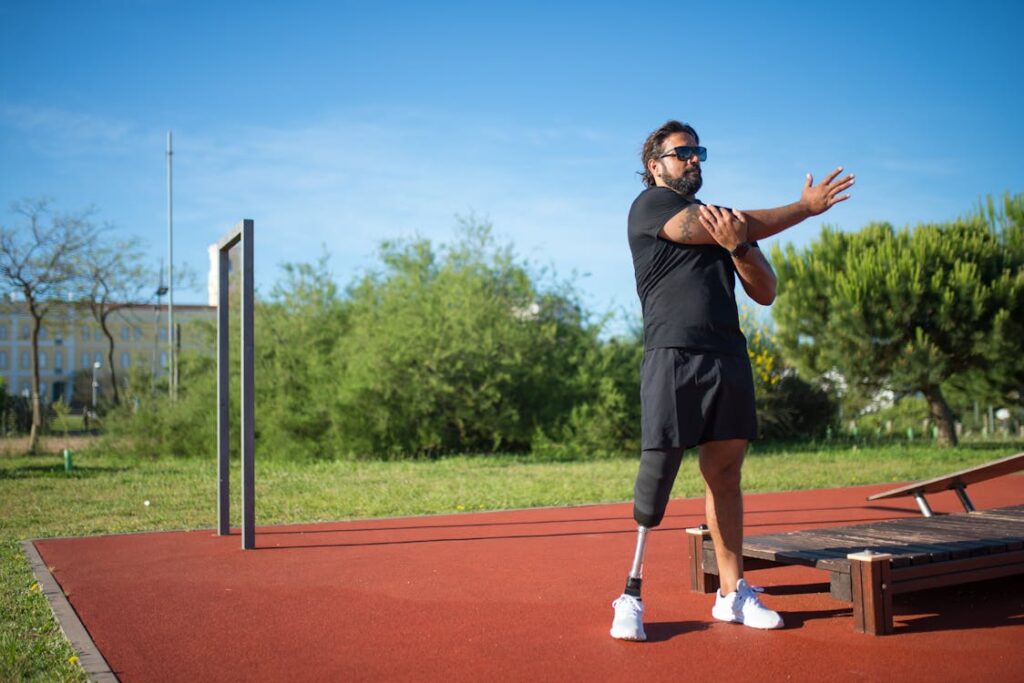
The Psychological Impact of Regaining Balance
Regaining balance after an amputation is not just a physical process—it is also a mental and emotional journey. Many amputees experience a period of uncertainty, where they feel like they are learning to trust their body all over again.
This lack of confidence can lead to hesitation, reduced mobility, and even social withdrawal. However, as balance improves, so does self-assurance, independence, and overall well-being.
Rebuilding Trust in the Body
After limb loss, it is common to feel disconnected from the body. Movements that once felt effortless—standing, walking, or even shifting weight—suddenly require conscious effort.
This change can be frustrating, and some amputees develop a fear of moving too much or too quickly in case they lose balance.
Balance training helps rebuild trust by gradually proving to the brain that movement is safe and controlled.
Each small success, whether it’s standing for a few seconds longer, walking a greater distance, or navigating uneven ground, reinforces confidence in the body’s ability to stay stable. Over time, these repeated experiences eliminate hesitation and create a sense of security.
Overcoming the Fear of Falling
One of the biggest mental barriers to movement after an amputation is the fear of falling. Many amputees worry about what might happen if they stumble, and this fear can prevent them from fully engaging in rehabilitation or daily activities.
Avoiding movement due to fear, however, only weakens muscles and slows down recovery.
A structured balance training program teaches how to react to sudden shifts in stability, how to use a prosthetic or remaining limb effectively, and how to recover safely if balance is lost.
As individuals practice and see that they can regain stability without falling, their fear diminishes. With every session, movement starts to feel less risky and more natural.
How Balance Training Improves Mental Health
Balance training is not just about physical control—it also has a powerful impact on mental health. Regular physical activity, including balance exercises, stimulates endorphins, which are natural mood boosters that reduce stress and anxiety.
Many amputees who engage in balance training report feeling more positive, more in control, and less emotionally drained.
Improved balance also allows for greater independence, which can significantly affect self-esteem and overall happiness. When someone can move freely without constantly worrying about stability, they feel more capable in daily life.
Whether it’s going for a walk, playing with children, or simply standing in a social setting, being able to move confidently helps reduce feelings of isolation and frustration.
The Connection Between Balance and Social Confidence
Many amputees experience moments of self-consciousness, especially in public settings. Struggling with balance or feeling unsure while using a prosthetic can sometimes make social interactions feel intimidating.
Some individuals may avoid social outings, family gatherings, or even work environments because they feel uncomfortable moving around others.
As balance improves, so does social confidence. When movement feels natural, amputees are less focused on how they appear to others and more focused on fully participating in life.
The ability to stand, walk, and engage in activities comfortably can restore a sense of normalcy, making social interactions less stressful and more enjoyable.
Setting and Achieving Personal Balance Goals
One of the most effective ways to stay motivated in balance training is by setting small, achievable goals. These goals can be as simple as standing for a few extra seconds without support, walking a slightly longer distance, or navigating a new type of terrain.
Each goal reached reinforces the idea that progress is happening, which keeps motivation high.
Many amputees find that balance training gives them a sense of accomplishment, even beyond mobility improvement.
It creates a mindset of growth and resilience, showing them that with patience and effort, they can continue to overcome obstacles and adapt to new challenges.
Turning Balance Training into a Lifestyle
Regaining balance is not just about rehabilitation—it’s about building a sustainable way of moving for the rest of life.
Amputees who maintain strong balance, posture, and core strength often experience fewer complications, less pain, and greater mobility well into the future.
By integrating balance exercises into daily routines, staying physically active, and maintaining a positive mindset, individuals can continue to build confidence in their movements for years to come.
Balance training is not just about learning to stand or walk again—it is about rediscovering freedom, confidence, and independence.
Conclusion
Regaining balance after an amputation is more than just a part of rehabilitation—it is the foundation for a confident, active, and independent life. Without balance, simple movements feel uncertain, mobility becomes exhausting, and daily activities can feel overwhelming. But with proper training, stability improves, movements become more natural, and confidence returns.
Balance training is not just about standing upright or walking without fear—it is about reclaiming control over your body and your life. It strengthens the core, improves posture, and allows amputees to move with greater ease and efficiency. With every small success—whether it’s standing a little longer, walking a bit farther, or navigating different terrains—comes a renewed sense of freedom and possibility.
At Robobionics, we understand that prosthetics are only part of the solution. True mobility comes from a combination of advanced technology and strong rehabilitation strategies. Whether you are adapting to a new prosthetic or simply working to improve your balance, our goal is to help you move with confidence, comfort, and independence.



